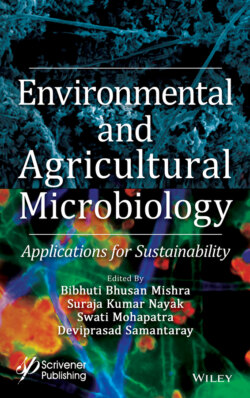Читать книгу Environmental and Agricultural Microbiology - Группа авторов - Страница 14
1.1 Introduction
ОглавлениеThe human population is constantly increasing at a fast rate and might reach around 9.7 billion people by 2050 [1]. To satisfy the food requirements of this enormous population, an enhancement in crop production is needed which open doors for the use of various agrochemicals. Agrochemicals (fertilizers and pesticides) are the group of chemicals used in agricultural practices to improve crop yield. Limited availability of macronutrients such as nitrogen, phosphorus, and potassium may result in poor growth of the crop. Thus, commercial fertilizers enriched with these ingredients may be applied to meet the demand of the essential elements. But plants can absorb only a limited amount of these nutrients and the excess fertilizer may be washed down along with the rain into water bodies and thereby causing contamination of the same [2].
Thus, uncontrolled and excessive use of fertilizers (e.g., phosphate fertilizer) may result in eutrophication of canals and reservoirs [3, 4]. In addition to chemical fertilizers, another chemical extensively used in agricultural activities is pesticides. These substances are utilized to control the infestations by crop destroying organisms referred to as pest and thereby enhancing agricultural productivity [5]. Although these agrochemicals are used to benefit humans, they have a hazardous impact on the environment [6]. Thus, with the use of several million tons of agrochemicals every year, the agricultural sector has been considered to be a major source of environmental pollution [7].
Among the various agrochemicals used in modern agricultural practice, pesticide and its residues pose a serious threat to environmental health and stability [8]. As a result, environmental pollution due to pesticide has become a major global concern. Pesticides can be defined as substances (or a mixture of substances) developed to repel or mitigate pests [9]. Pesticides include a wide array of compounds intended to reduce crop destroying agents such as insects, weeds, fungi, and rodents. These pesticides vary in their physical as well as chemical properties, and hence, it is important to classify them which make their study convenient. Although there are various ways of pesticide classification, the one based on their chemical composition are the most used one. This type of classification provides a proper correlation between structural features, activity, toxicity, and degradation mechanisms, among different members [5]. Based on chemical composition, pesticides have been classified into four major classes, namely, organochlorines, organophosphorus, carbamates, and pyrethroids [10]. Table 1.1 shows the chemical composition and general characteristics of important pesticides [11, 12].
Table 1.1 Chemical composition and general characteristics of different pesticide groups [11, 12].
| Group | Chemical Composition | General Characteristics | Example |
| Organochlorines | Composed of C, H, Cl, and sometimes “O” is also present. | Lipid soluble, accumulation in fat rich animal tissue, persistent for a longer period, nonpolar in nature. | Lindane, endosulfan, mirex, DDT |
| Organophosphate | Phosphorus atom occupies central position within the molecule. They may be heterocyclic, cyclic, and aliphatic. | Shows solubility in water and organic solvents, low persistence compared to organochlorines, the central nervous system gets affected by these compounds. | Diazinon, methyl parathion, malathion |
| Carbamates | Chemical structure is similar to a plant alkaloid produced by Physostigma venenosum. | Derived from carbamate acid; have high vertebrate toxicity; less persistent. | Carbaryl, sevin |
| Pyrethroids | Chemical structure is based on pyrethrin obtained from Chrysanthemum cinerariifolium. | Affect the nervous system; are less persistent compared to other pesticides. | Pyrethrins |
Although pesticides benefit human by enhancing agricultural productivity, they adversely affect human beings as well as other non-target organisms (explained in details in Section 1.2). Thus, remediation of these anthropogenic compounds is highly essential. Scientists have developed several physical and chemical remediation methods such as adsorption, oxidation, ozonation, nanofiltration, and membrane filtration ultrasonic irradiation for pesticide elimination from the environmental matrices and thereby minimizing their hazardous influences [13, 14]. But unfortunately, most of these methods are not environment-friendly and the cost associated with them is very high. As such, there is a requirement of an alternative technology devoid of these limitations. Bioremediation being inexpensive and eco-friendly proves itself as a potential replacement to various physical and chemical remediation methods. Earlier researchers have focused mainly on bioremediation using fungal and bacterial strains [15]. But recently, microalgae have received sufficient attention as an efficient bioremediation candidate due to their versatile metabolic activities, low-cost nutritional requirements (solar light and CO2), and ability to survive in different environmental conditions [13]. The aim of this article is to summarize and evaluate the various aspects of bioremediation of pesticides using microalgae with attention on microalgal species involved, strategies, molecular basis, and factor affecting the process.
